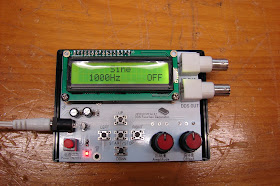I recently purchased a function/signal generator on eBay. I bought it because my computer based signal generator was limited to a top frequency of only 20KHz and I wanted to go a little higher. I also wanted a signal generator for my "Fringe Electronic Devices" book. I wanted to write about the signal generator for people who do not have, or do not know how to use, a computer based frequency generator. I was delighted that this signal generator works great, and that the very limited instructions do in fact cover what is needed to get it to work.
I added spacers under the bottom two corners of the LCD to hold it in place and hot melt glued the function generator into a 3.25 inch by 4.25 inch project box. I had to trim the bottom edge of the project box as the circuit board was just a little bit too big to fit otherwise. A box that was 4 inches by 3.25 inches would have been a better fit.
The function generator will run on a 9V AC adapter or on a 9 volt battery with no problems. What the signal generator is equivalent to is an Arduino with a resistor ladder based analog to digital converter. Then there is an Op amp buffer amplifier to drive the output jacks. I was able to find a schematic of an earlier version of the device.
My function generator did not come with a back-lit LCD so I swapped another one in. It is a standard 1602 LCD display. At first it did not work at all! The first problem is a 50 ohm resistor above the LCD jack that needs to be soldered in for the back-light. The second problem is that the LCD contrast trimmer is located underneath the LCD. You have to play with it to get the right setting. I was tempted to unsolder the trimmers single pin, bend it up on the other two pins and solder a jumper from the single pin to the circuit board. That way you could adjust the trimmer while watching the LCD to see if it is the best setting.
Here is what comes with the function generator, I fixed up the English to make it more readable.
Specifications:
• Operating voltage: DC9-12V
• DDS frequency range: 1HZ-65534Hz.
• High-speed frequency (HS) output up to 8MHz;
• DDS signal amplitude and the offset amount can be adjusted separately by two potentiometers.
• DDS signals: sine wave, square wave, sawtooth, reverse sawtooth, triangle wave, ECG wave.
• 1602 LCD menu.
• Intuitive keyboard.
• Section rate steps: 1,10,100,1000,10000 Hz.
(How fast it steps when you push the right and left frequency up/down buttons)
• The power automatically restores the settings that were used the last time.
• Offset range: 0.5V pp to 5V pp
• Amplitude amount: 0.5V pp to 14V pp
Key Functions:
The UP button selects the waveform
The DOWN button selects the waveform
The LEFT button decreases the frequency
The RIGHT button increases the frequency
The START / STOP button turns the output waveform on and off
(In the off state, the "left "and "right" keys set the output frequency. The middle button starts and stops the selected waveform)
"UP" output waveform selection order:
High Speed = Use the high frequency output
Noise Random = random noise output
Freq Step = Size of steps
ECG = electrocardiogram wave
Rev Sawtooth = reverse sawtooth
SawTooth = sawtooth
Triangle = triangle wave
Square = square wave
Sine
This picture is what it looks like without the LCD.



No comments:
Post a Comment